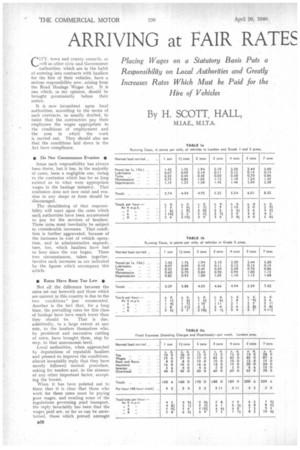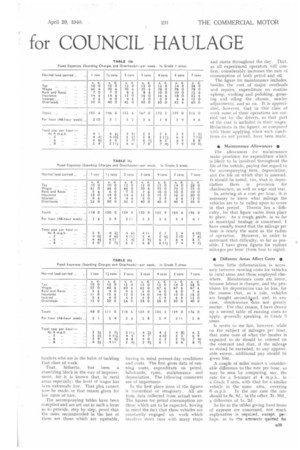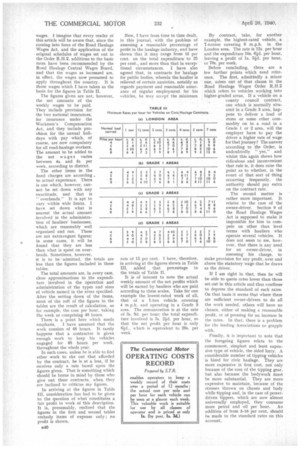ARRIVING at FAIR RATES
Page 56

Page 57

Page 58

If you've noticed an error in this article please click here to report it so we can fix it.
for COUNCIL HAULAGE
Placing Wages on a Statutory Basis Puts a Responsibility on Local Authorities and Greatly Increases Rates Which Must be Paid for the Hire of Vehicles
By H. SCOTT HALL,
M.I.A.E., M.I.T.A.
CITY, town and county councils, as well as other civic and Government authorities, which are in the habit of entering into contracts with hauliers for the hire of their vehicles, have a serious responsibility now, arising from the Road Haulage Wages Act. It is one which, in my opinion, should be brought prominently before their notice.
It is now incumbent upon local authorities, according to the terms of such contracts, as usually drafted, to insist that the contractors pay their employees the wages appropriate to the conditions of employment and the area in which the work is carried out. They should also see that the conditions laid down in the Act have compliance.
• Do Not Countenance Evasion • Some such responsibility has always been theirs, but it has, in the majority of cases, been a negligible one, owing to the confusion which has for so long existed as to what were appropriate wages in the haulage industry. That confusion does not now exist and evasion in any shape or form should be discouraged.
The shouldering of that responsibility will react upon the rates which suck authorities have been accustomed to pay for the services of hauliers. Those rates must inevitably be subject to considerable increases. That condition is further aggravated, because of the increases in cost of vehicle operation, and in administrative expenditure, too, which hauliers have had to bear since the war began. These two circumstances, taken together, involve such increases as are indicated by the figures which accompany this article.
• Rates Have Been Too Low •
Not all the difference between the rates set out herewith and those which are current in this country is due to the two conditions" just enumerated. Another is the fact that, for a long time, the prevailing rates for this class of haulage have been much lower than they should be. That is due, admittedly, to a large extent at any rate, to the hauliers themselves who, by persistent and successive cutting of rates, have brought them, step by step, to that uneconomic level.
Local authorities, when approached by deputations of reputable hauliers and pressed to improve the conditions, almost invariably reply that they have merely followed normal procedure. asking for tenders and, in the absence of any other important factor, accepting the lowest. When it has been pointed out to them that it is clear that those who work for these rates must be paying poor wages, and evading some of the regulations governing _road transport, the reply invariably has been that the wages paid are, so far as can be ascertained, those which prevail amongst hauliers who are in the habit of tackling that class of work.
That, hitherto, has been a stumbling block in the way of improvement, for it is known that, in rural areas especially; the level of wages has been extremely low. That plea cannot now be made, or that reason given for low rates of hire.
The accompanying tables have been compiled and arc set out in such a form as to provide, step by step, proof that the rates recommended in the last of them are those which are equitable, having in mind present-day conditions and costs. The first gives data of running costs, expenditure on petrol, lubricants, tyres, maintenance and depreciation. The following comments are of importance.
In the first place none of the figures is theoretical or imaginary. All are from data eollected from actual users. The figures for petrol consumption are those which are to be expected, having in mind the fact that these vehicles are constantly engaged on work which involves short runs with many stops and starts throughout the day. That, as all experienced operatofs will confirm, considerably increases the rate of consumption of both petrol and oil.
The figure for maintenance includes, besides the cost of major overhauls and repairs, expenditure on routine upkeep, washing and polishing, greasing and oiling the chassis, sundry adjustments, and so On. It is appreciated, however, that in this class of work some of these operations are carried out by the drivers, so that part of the cost is included in their wages. Reductions in the figures, as compared with those applying when such conditions do not prevail, have been made.
• Maintenance Allowances • The. allowances for maintenance make provision for expenditure which is likely to be involved throughout the life of the vehicle, paying due regard to the accompanying item, depreciation, and the life on which that is assessed. It should he noted, too, that in depreciation there is provision for obsolescence, as well as wear and tear.
In arriving at a cost per hour, it is necessary to know what mileage the vehicles are to be called upon to cover
in that period. Therein lies a difficulty, for that figure varies from place to place. As a rough guide, in so far as municipal haulage is concerned, I have usually found that the mileage per hour is nearly the same as the radius of operation. However, in order to surmount that difficulty, so far as possible, I have given figures for various mileages per hour (from four to eight).
• Different Areas Affect Costs •
Some little differentiation is necessary between running costs for vehicles in rural areas and those employed elsewhere. Maintenance costs are tower, because labour is cheaper, and the provision for depreciation can be less, for the reason that, as a rule, vehicles are bought second-Ind, and, in any case, obsolescence does not greatly matter. For that reason, I have drawn up a second table of running costs to apply, generally speaking. in Grade :1 areas.
It seems to me fair, however, while on the subject of mileages per hour, that some note of shat the haulier is expected to do should be entered on the contract and that, if the mileage so stated be exceeded, to any appreciable extent, additional pay should he given him.
A couple of miles makes a considerable difference to the rate per hour, as may be seen by comparing, say, the rate for a 5-tonner at 4 m.p.h., in • a Grade 1 area, with that for a similar vehicle in the same area, covering
6 m.p.h. In the one case the rate should be 43s. 8d., in the other, 7s. lf)d., a difference of is. 2d.
So far as the tables giving fixed items of expense are concerned, not much explanation is required, except, perhaps, as to the amounts quoted for wages. I imagine that every reader of this article will be aware that, since the coming into force of the Road Haulage Wages Act, and the application of the original schedules of wages set out in the Order R.H.2, additions to the basic rates have been recommended by the Road Haulage Central Wages Board, and that the wages as increased are, in effect, the wages now presumed to apply throughout the country. It is those wages which I have taken as the basis for the figures in Table II.
The figures given are not, however, the net amounts of the weekly wages to be paid. They include provision for the two national insurances, for insurance under the Workmen's Compensation Act, and they include provision for the annual holidays with pay which, of course, are now compulsory For all road-haulage workers. The amount to be added to the net wages varies between 4s. and 5s. per week, according to district.
The other items in the fixed charges are according to actual experience. There is one which, however, cannot be set down with any exactitude, and that is " overheads." It is apt to vary within wide limits. I have set down what is nearest the actual amount involved in the administration of hauliers' businesses, which are reasonably well organized and run. These are not extravagant figures: in some cases, it will be found that they are less than what is spent on overheads. Sometimes, however, it is to be admitted, the totals are less than the figures included in these tables.
The total amounts are, in every case, close approximations to the expenditure involved in the operation and administration of the types and sizes of vehicle named in the areas specified. After the setting down of the items, most of the regt of the figures in the tables are the result of calculation, as for example, the cost per hour, taking the week as comprising 48 hours.
There is a point here which needs emphasis. I have assumed that the week consists of 48 hours. It rarely happens that a contractor is given enough work to keep his vehicles engaged for 48 hours per week, throughout the whole year.
In such cases, unless he. is able to find other work to eke out that afforded by the contract, he is at a loss, if he receives only a rate based upon the figures given. That is something which should be borne in mind by those who give out these contracts, when they are inclined to criticize my figures.
In arriving at the figures in Table III, consideration has had to be given to the question of what constitutes a fair profit in work of this description. It is, presumably, realized that the figures in the first and second tables embody items of expense only ; no profit is shown.
Now, I have from time to tine dealt, in this journal, with the problem of assessing a reasonable percentage of profit in the haulage industry, and have shown that it may range from 15 per cent, on the total expenditure' to 25 per cent., and more than that in exceptional circumstances. I have also agreed that, in contracts for haulage for public bodies, wherein the haulier is relieved of certain anxieties, notably as regards payment and reasonable assurance of regular employment for his vehicles, he may accept the minimum
rate of 15 per cent. I have, therefore, in arriving at the figures shown in Table III, added that percentage to the totals of Table H.
It is of interest to note the actual weekly amount of the net profits which will be earned by hauliers who are paid according to these scales. Take for one example the lowest-rated work of all, that of a I-ton vehicle covering 4 m.p.h. and operating in a Grade 3 area. The remuneration is at the rate of 3s. 9d. per hour; the total expenditure involved is 3s. 21d. per hour, so that the net profit per hour is only 60., which is equivalent to 26s. per week. By contrast, take, for another example, the highest-rated vehicle, a 7-tonner covering 8 m.p.h. in the London area. The rate is 12s. per hour and the expenditure 10s, flid. per hour, leaving a profit of is. 50. per hour, or 70s, per week.
Before concluding, there are a few further points which need reference. The first, admittedly a minor one, arises out of that clause in the Road Haulage Wages Order R.H.2 which refers to vehicles working into higher-graded areas. If a vehicle on a county council contract, one which is normally situated in a Grade 3 area, happens to deliver a load of stone or some other commodity on to a road in a Grade 1 or 2 area, will the employer have to pay the driver a higher rate of wage for that journey? The answer
raCtS.
7 tons
s. d.
90
• according to the Order, is undoubtedly " yes," and whilst this again shows how ridiculous and inconvenient that rule is, it does raise the point as to whether, in the event of that sort of thing occurring frequently, the authority should pay extra on the contract rate.
The second matter is rather more important. It relates to the case of the owner-driver, Section 9 of the Road Haulage Wages Act is supposed to make it impossible for him to compete on other than level terms with hauliers who operate several vehicles. It does not seem to me, however, that there is any need for an owner-driver, in assessing his charge, to make provision for any profit, over and above the statutory wage that he draws as the driver.
711
88 96 11 0 7 I
79
86 10' 0
If I am right in that, then he will be able to quote rates lower than those set out in this article and thus continue to depress the standard of such rates. On that basis it seems that where there are sufficient owner-drivers to do all the work needed, others will have no chance, either of making a reasonable profit, or of pressing for an increase in the rates. In that, there is a problem for the leading Associations to grapple with.
Finally, it is important to note that the foregoing figures relate to the commonest, simplest and least expensive type of vehicle, the sided lorry. A considerable number of tipping vehicles is hired for civic haulage. They are more expensive in first cost, not only because of the cost of the tipping gear, but also because the bodywork must be more substantial. They are more expensive to maintain, because of the stresses thrown on chassis and body while tipping and, in the case of powerdriven tippers, which are now almost universally employed, they consume more petrol and oil per hour. An addition of from 5-10 per cent, should be made to the standard rates on this account.




































































































